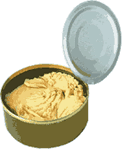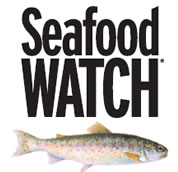| |
Mercury in Fish
This article presents information on mercury levels in fish, including mercury in tuna. It lists guides to help you determine which are fish high in mercury, and points to other resources for mercury in fish. Updated Mar-2009
 |
 |
HATE MAIL FROM SOME FLOUNDER
Mercury in Fish – Which Fish, and Why?
|
|
Unless you're like The Addams Family's Uncle Fester, who delighted in occasionally having a mercury thermometer as a snack,
 any mercury exposure you may suffer probably comes from eating certain types of fish. Unfortunately, that favorite "sandwich fish" of ours—"solid white" tuna—is one of the most contaminated little fishies.
any mercury exposure you may suffer probably comes from eating certain types of fish. Unfortunately, that favorite "sandwich fish" of ours—"solid white" tuna—is one of the most contaminated little fishies.
Many of you may remember the mercury-in-tuna advisory a few years back from the US EPA and FDA that said we should limit consumption of tuna. But by how much? And what other fish have a mercury problem? How might we be affected by eating mercury-tainted fish? How did things get this way, and what can we do about it?
The first question we'll tackle is how planet earth turned into planet mercury.
We humans may get small amounts of direct exposure to elemental mercury—for instance, from a broken mercury thermometer, by breathing polluted air from a nearby coal-fired power plant, or from the mercury-based preservative found in many vaccines. The majority of our mercury exposure, however, is from eating certain species of fish. But mercury is not a natural toxin in fish, so how did it get there?
The chain of events goes something like this:
- Mercury gets into the air as a byproduct of industrial activities such as power generation from coal; garbage incineration; recycling of older automobiles; and some types of mining, manufacturing, and chlorine production. Smaller volumes of mercury are also released through volcanic eruptions and rock weathering.
- From there, the airborne mercury is deposited on land and water, where microorganisms convert it into a more biologically active form, methylmercury.
- The methylmercury then works its way up the food chain. Because organisms tend to store mercury, not excrete it,
 concentrations of mercury get higher and higher as larger, longer-living creatures gobble up smaller ones. By the time you get to a top predator fish like a swordfish, albacore tuna, or shark, the concentrations are quite high. Fish can also absorb methylmercury directly from water as it passes over their gills, though this is a lesser avenue of accumulation.
concentrations of mercury get higher and higher as larger, longer-living creatures gobble up smaller ones. By the time you get to a top predator fish like a swordfish, albacore tuna, or shark, the concentrations are quite high. Fish can also absorb methylmercury directly from water as it passes over their gills, though this is a lesser avenue of accumulation.
- When humans eat mercury-contaminated fish, they get the mercury that's in the fish's flesh.
According to Physicians for Social Responsibility (PSR), research has shown that:
- short-term exposure to high concentrations of mercury vapor has harmful effects on the nervous system, digestive system, respiratory system, and kidneys;
- long-term exposure to mercury can permanently damage the brain and kidneys at any age;
- long-term animal studies have also found that exposure to organic mercury (such as methylmercury) at high levels can cause nervous system damage; damage to the kidneys, stomach, and large intestine; changes in blood pressure and heart rate; adverse effects on male reproductive organs, sperm, and developing fetuses; and an increase in the number of spontaneous abortions and stillbirths.
Because mercury is particularly troublesome for developing nervous systems, fetuses, infants, and young children are most at risk. According to PSR, epidemiologic studies have found that children exposed to even low levels of mercury before birth experience subtle symptoms of neurological damage. Specific effects include poor performance on neurobehavioral tests (particularly on tests of attention), fine motor function, language, and memory.
 The National Academy of Sciences states that mercury in pregnant women disrupts the development of brain cells in their babies. A report by Centers for Disease Control concluded that one in six women of childbearing age have mercury in their blood above the level that would pose a risk to a developing fetus. Clearly, pregnant women and children should exercise extra caution when it comes to fish consumption.
The National Academy of Sciences states that mercury in pregnant women disrupts the development of brain cells in their babies. A report by Centers for Disease Control concluded that one in six women of childbearing age have mercury in their blood above the level that would pose a risk to a developing fetus. Clearly, pregnant women and children should exercise extra caution when it comes to fish consumption.
Choosing the right types and amount of fish to eat is essential. Here are several useful tools that will help you reduce mercury exposure for you and your family by helping you determine which fish are safe to eat and in what quantities.
- PSR Guide: The Physicians for Social Responsibility (PSR) has a
fish guide document
(NO LONGER AVAILABLE) that includes a wallet-sized card that rates fish for mercury contamination. However, be sure to pay attention to the little "over-fished" symbol next to some species so you don't solve your mercury problem only to contribute to the decline of a disappearing fish species.
Note: PSR's fish guide PDF mentions the URL "www.mercuryaction.org" as a place to go for more information. That URL is out-of-date (and now in fact points to a pro-mercury propaganda site). The correct "Mercury In Fish" information paper from PSR can be found
here.
- Tuna Tabulator/Tuna Calculator: The Natural Resources Defense Council has put together a
table for tuna consumption
based on the US EPA's mercury guidelines, which are more cautious that the FDA's guidelines (which, unfortunately, tend to have dominant influence on recommendations made by mainstream food experts). The NRDC table lets you figure out the safe amount of tuna for you or your child based on body weight and tuna type (solid white or chunk light). Similarly, the Environmental Working Group has a
calculator-style tool
that helps you do the same thing.
 Caught fish: Remember that some geographical areas are exposed to more mercury than others, so fish that you, your family, or your friends catch from local bodies of water could be more contaminated than the national average. Many states, including Grinning Planet's home state of Kentucky, have issued local-fish advisories tied to mercury.
Caught fish: Remember that some geographical areas are exposed to more mercury than others, so fish that you, your family, or your friends catch from local bodies of water could be more contaminated than the national average. Many states, including Grinning Planet's home state of Kentucky, have issued local-fish advisories tied to mercury.
US EPA data show that more than three-quarters of fish sampled from the nation's lakes have mercury levels that are high enough to pose a threat women of childbearing age and children younger than three. (And the rest of us can take our chances, I guess.) You can
check your state
for advisories about the safety of fish in your local lakes, rivers, and coastal areas. If no advice is available, FDA recommends that you eat no more than 6 ounces per week of any fish you catch from local waters and that you not consume any other fish during that week.
On the surface, it's easy to identify the black hats in the mercury-pollution game: they're the ones who are dragging their feet on reducing mercury air pollution. That typically includes any industry whose processes emit mercury, but the unrelenting lobbying by the coal industry against tougher mercury standards has been particularly odious.
|
To be fair, the public hasn't done much to demand reductions in mercury pollution, and most of us have enjoyed the benefits of cheap-but-dirty coal-generated electricity for decades (as well as the fruits of the other industrial processes the cause mercury pollution). Still, many manufacturing sources have been greatly cleaned up, and the focus is now squarely on coal-fired power plants, which are the largest source of mercury air emissions worldwide.
|
MERCURY RELEASES –
NATURAL VS. MANMADE |
|
Coal-industry boosters and other defenders of mercury-polluting industries sometimes assert that human-caused releases of mercury are insignificant compared to releases from natural sources like volcanoes. Not so, according to the United Nations Environment Programme, which estimates that human activities have tripled the amount of atmospheric mercury. The US Geological Survey agrees—they estimate human activities have doubled or tripled the amount of mercury in the atmosphere over the past 150 years relative to the pre-industrial baseline.
|
|
It's a shame that we have let the mercury problem fester for so long. It would have been worth a few extra bucks every month on our power bills to keep the fish supply clean. But it's better that we take action late instead of never. The technology exists to reduce emissions from dirty coal-fired power plants by 90% within a few years—much better than the "70% reduction of mercury by 2018" plan previously pushed by the Bush Administration. We should accept nothing less the 90% solution.
You can keep up with the latest in "mercury in fish" stuff and other air-pollution issues at
NRDC's Air page.
|
| |
ADVERTISEMENT

For more reviews or purchase info, click on any title to go to Amazon.com
| |
 |
Diagnosis: Mercury
Money, Politics, and Poison (by Jane M. Hightower)
Mercury, a toxic element that has been plaguing us for centuries, is now showing up in fish. While mercury is a naturally occurring element, there's much that is unnatural about this poison's prevalence in modern-day seafood. Diagnosis: Mercury traces the prevalence of mercury poisoning, revealing how dubious studies, political calculations, and industry lobbyists have combined to endanger our health.
|
| |
| |
 |
Bottomfeeder (by Taras Grescoe)
How to Eat Ethically in a World of Vanishing Seafood
Dividing his sensibilities between Epicureanism and ethics, Taras Grescoe set out on a nine-month, worldwide search for a delicious—and humane—plate of seafood. What he discovered shocked him. From North American Red Lobsters to fish farms and research centers in China, Bottomfeeder takes readers on an illuminating tour through the $55-billion-dollar-a-year seafood industry. Grescoe examines how out-of-control pollution, unregulated fishing practices, and climate change affect what ends up on our plate. More than a screed against a multibillion-dollar industry, however, this is also a balanced and practical guide to eating, as Grescoe explains to readers which fish are best for our environment, our seas, and our bodies.
|
| |
| |
 |
Silent Scourge (by Colleen Moore)
Children, Pollution, and Why Scientists Disagree
How does pollution impact our daily lives and our children's development? Why do industry and environmental experts disagree about what levels of pollutants are safe? Silent Scourge explains how mercury, noise, pesticides, lead, dioxins, PCBs and technological disasters such as Chernobyl and Love Canal can damage children's development.
|
| |
| |
 |
The End of the Line (by Charles Clover)
How Overfishing Is Changing the World and What We Eat
Ninety percent of the large fish in the world's oceans have disappeared in the past half century, causing the collapse of fisheries along with numerous fish species. In this hard-hitting, provocative exposť, Charles Clover reveals the dark underbelly and hidden costs of putting food on the table at home and in restaurants. From the Tsukiji fish market in Tokyo to a seafood restaurant on the North Sea and a trawler off the coast of Spain, Clover pursues the sobering truth about the plight of fish. Along with the ecological impact wrought by industrial fishing, he reports on the implications for our diet, particularly our need for omega-3 fatty acids. This intelligent, readable, and balanced account serves as a timely warning to the general public as well as to scientists, regulators, legislators, and fishing enthusiasts.
|
| |
Or see more books on GP:
|
Back to Funny Names/Fish Joke page
Back to Cartoon - Waitress Humor page
Environmental Cartoons
Jokes/Cartoons (non-eco)
FREE AUDIO CLIPS

|
|
|
|
|
Hey, we don't pick
the Google ads! – GP
|
| |
| CLICKS ON OUR ADS AND PURCHASES VIA OUR AMAZON LINKS HELP SUPPORT THIS FREE SITE... THANKS! |
|
|
| |
THE NEW N.I.H. —
"NOT INTERESTED IN HEALTH" |
 |
MERCURY, VACCINES, AND AUTISM — A very good (if slightly technical) interview with Dr. Boyd Haley, a medicinal chemistry expert. He discusses autism and other health implications of vaccines containing mercury-based thimerosal, as well as the shockingly irresponsible positions of the National Institutes of Health and other parts of the medical establishment. From AutismMedia.org via
YouTube
|
"We wanted albacore on the list of fish not to eat. We knew that wouldn't happen because of the pressure from the industry, but we certainly didn't think there should be a recommendation to eat [as much as] six ounces of albacore."
— Vas Aposhian, University of Arizona toxicologist, upon resigning in protest from the mercury-in-fish advisory panel, 2004
| |
| GOOD FISH, BAD FISH |
 |
SEAFOOD WATCH GUIDE
Want to avoid fish with mercury and PCB contamination? Want to NOT be the guy who eats the last surviving Chilean seabass? Check out the Seafood Watch pocket guide -- a combined effort from Monterey Bay Aquarium and Environmental Defense. Go there
|
|
|


